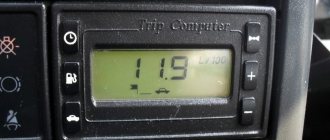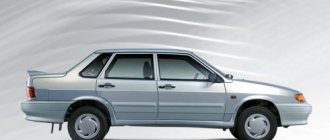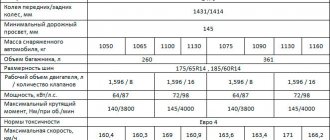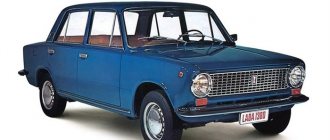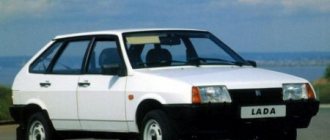VAZ-2112 is a compact car manufactured in 1999, produced at the AvtoVAZ plant in Tolyatti. The hatchback of the same name is one of the modifications of the “ten” VAZ-2110 in a sedan body. A station wagon was also produced on the basis of this model. The car was produced until 2008; on the VAZ-2112 assembly line it was replaced by the more modern Lada Priora hatchback, which is the successor to the entire “tenth” family. In addition to the five-door hatchback, the VAZ-2112 also had a three-door Coupe modification. This version was produced in limited edition.
VAZ-2112 engines. Official fuel consumption per 100 km.
Gasoline:
- 1.5, 72 l. sec., manual, 14 sec to 100 km/h, 9/5.6 l per 100 km
- 1.5, 94 l. sec., manual, 12.5 sec to 100 km/h, 9.4/5.9 l per 100 km
- 1.5, 78 l. sec., manual, 14 sec to 100 km/h, 10/5.7 l per 100 km
- 1.5, 92 l. sec., manual, 12.5 sec to 100 km/h, 9.8/6.1 l per 100 km
- 1.6, 81 l. sec., manual, 13.5 sec to 100 km/h, 10/6 l per 100 km
- 1.6, 90 l. sec., manual, 12.5 sec to 100 km/h, 9.4/5.9 l per 100 km
- 1.8, 98 l. pp., manual, 10 sec to 100 km/h
Methods for solving the problem
To eliminate increased fuel consumption, it is worth understanding the design features of not only the main power unit, but also the auxiliary systems on which the operation of the engine as a whole depends. Thus, several systems become the causes at once. But how can we determine where exactly the malfunction occurred? To do this, consider the sequence of diagnostic and repair actions for systems.
Sensors and ECU
When any engine malfunction occurs, the first place you need to “climb” is the electronic control unit. Often, errors are hidden here, and you can also see where the problem is hiding. To perform diagnostics, you need to connect via a tablet or laptop to the “brains” of the car using a USB – K-line cable.
Diagnostics through the instrument panel of VAZ-2112
The explanation of the errors that could be seen in the video is given below in the picture.
ECU error codes and their decoding The first reason may be the accumulated errors in the unit itself, where the commands already contradict each other, and the injectors began to supply an increased amount of the fuel mixture. The treatment is simple - resetting errors or installing a new operating system. Many car owners recommend Paulus.
If resetting the ECU errors did not help, then it is worth checking the functionality of the sensors that are responsible for the air-fuel mixture, namely:
- Mass air flow sensor.
- Lambda probe.
- Throttle position sensor.
- Temperature sensor.
Engine control circuit and sensors
It is these sensors that can cause fuel consumption to increase. If diagnostics show that one of them is faulty, it must be replaced. If, however, the consumption remains the same, you need to move on and look for the problem in another unit.
Fuel system
It is in the fuel system that the mystery of increased engine fuel consumption may lie. First of all, you need to check the pressure in the fuel pipes and fuel rail. Several parts that have failed for various reasons can contribute to this effect.
Dirty fuel module mesh The first two elements that are worth checking are the fuel pump and the fuel filter. Dismantling the fuel module may be a clue, since the filter mesh could simply be clogged. But the filter is not visible, so you just have to change it. Low-quality fuel, which is saturated in the modern gasoline market, as well as low-quality spare parts can cause this unit to fail ahead of time.
None A dirty throttle valve can be easily cleaned using VD-40. If the fuel system has been checked, all elements have been replaced and cleaned, but the consumption is still high, you should pay attention to the injectors.
Injector
The injector, namely dirty or non-working injectors, can cause increased fuel consumption. Some motorists believe that they can dismantle these elements, connect a compressor and blow out the injectors, and they will become clean. This is a misconception - this will only increase consumption!
The only way to check these elements is to remove them and install them on a special stand that performs diagnostics and cleaning. If necessary, damaged elements must be replaced.
Different types of spraying of injector nozzles during diagnostics.
Engine temperature
Engine temperature has a direct impact on fuel consumption. 98-103 degrees - engine operating temperature. The photo shows the editorial car!
Considers the optimal indicator to be 98-103 degrees Celsius , at which the mixture is optimal. If the temperature becomes higher, then the lean mixture is expressed not only in loss of power, but also in increased consumption, but when warming up, the mixture is discharged, and forced rich injection occurs, which consumes 20% more fuel . Therefore, it is constantly necessary to monitor the temperature and prevent the engine from overheating. In case of overheating, special attention should be paid to the performance of the fan and thermostat.
Increased temperature of the VAZ-2112 engine.
Faulty catalyst
In this case, the boomerang effect operates; the more efficiently the catalyst works, the more “standard” fuel consumption is. It is because of the contamination and destruction of this important element that a rich mixture is obtained, which subsequently has the effect of increasing consumption. Therefore, to fix the problem, you need to examine the node and determine its condition. Replace if necessary.
The failure of the catalyst can be seen visually. Symptoms: burning or destruction.
Air filter
The last reason for increased consumption is a dirty air filter. A special mention should be made of filter contamination with oil. This element performs the function of filtering incoming air into the fuel mixture. So, if it is dirty, the effect of “air starvation” may occur and the operation of the mass air flow sensor may malfunction. As a result, incorrect mixture formation occurs, which will entail an increase in consumption. If necessary, it is worth replacing this element with a new one.
Dirty air filter removed from the car.
VAZ-2112 owner reviews
With a 1.5 manual transmission engine, 16 valves. 92 l. With. petrol
- Konstantin, Magnitogorsk. A wonderful car, this is my youth. The car was produced in 2000, sold it with 155 thousand km mileage. A reliable car, with cheap spare parts and very economical. The dynamics of the Dvenakhi are amazing, acceleration to hundreds in 12 seconds. Excellent directional stability - in my opinion, the best of all budget cars. I have something to compare with - I drove Amulet, Logan and more. Gasoline consumption per 100 km was 10 liters per 100 km with the most dynamic driving.
- Boris, St. Petersburg. I like the car, I still drive it. At first I planned to take a sedan, but it seemed too fat-assed to me, which was somehow indecent. In the end, I took the hatchback, it looks more modern and sporty. With a 1.5-liter engine it consumes 8-10 liters of gasoline per 100 km.
- Dmitry, Kazan. Not a bad car for the money, I drive it and enjoy it. A typical means of transportation from point A to point B. Well, it’s ideal for country travel, since high reliability allows this. The car breaks down in small ways, and most of the breakdowns can be solved yourself. To do this, it is enough to have a pelvic guide kit and a reference book. Gasoline consumption with a 1.5 engine reaches no more than 10 liters in the city.
- Nikolay, Donetsk. A comfortable and dynamic car, with soft suspension and good handling. The car has been thoroughly studied by our servicemen, so I can be calm. Consumption of 9-10 liters of gasoline is quite satisfactory.
- Leonid, Zhitomir. I bought the car in 2005, with a 1.5-liter petrol engine. The engine produces 92 horsepower, which I think is enough for most trips. Not a bad car, if you don't pick too much. It does not bother you with breakdowns, and pleases you with its economical engine - in the city it produces an average of 8 liters.
- Svetlana, St. Petersburg. My brother gave me the car and he moved to Solaris. Sly guy, so be it. Dvenashka is my first car, I like the hatchback body. It looks sporty and brutal; this design is unlikely to ever become outdated. A powerful 90-horsepower engine consumes 10 liters of gasoline.
- Yana, Odessa. My twelfth has driven 100 thousand km, I have the car serviced and have no problems. Spare parts are cheap. Consumption is 8-11 liters per 100 km, I drive very fast.
With engine 1.6 89 l. With. 16 valves. manual transmission petrol
- Alexander, Donetsk. At the moment, the car has 98 thousand miles, and for the Russian automobile industry as a whole, the car behaves with dignity. Comfortable and dynamic, with a consumption of 7-10 liters per hundred. The five-speed manual transmission works flawlessly. Soft suspension, just right for our roads.
- Konstantin, Ekaterinoslavl. VAZ-2112 is, in my opinion, the best thing AvtoVAZ has created. The hatchback rides nicely and brakes well. Good handling by the standards of those years, definitely better than any Chinese. A car with a 1.6-liter engine consumes 10 liters per hundred.
- Veniamin, Saratov. The car is a 2011 model, a car made in Ukraine. Still a fresh copy, with a 1.6 engine consumes no more than 11 liters of gasoline
- Nikolay, Kharkov. I liked the car, who wouldn’t like it. Especially if this is your first car, for all occasions. I bought it in the late 1990s, I still remember the day of purchase. We chipped in with some student kids, picked it up from the car dealership, and headed off into the distant darkness. The 1.6-liter engine is powerful and flexible, with a consumption of 9 liters of 92-octane gasoline. The interior is comfortable, the suspension is soft. I really liked the handling on the highway. The directional stability is truly a sight for sore eyes, no worse than European foreign cars (my friend has a Focus). In general, the car is good for the money, you won't find a better one.
- Oleg, Dnepropetrovsk. The Lada Twelfth impressed me; until recently I was contemptuous of domestic cars. I drove mostly foreign cars. The last one I had was a second generation Toyota Corolla. I crashed it, but there was no money for a new car. So we had to take a used Lada, and it was in good condition. The car turned out to be quite reliable, moderately economical and dynamic. Eats a maximum of 10 liters of gasoline per hundred. In general, I gave myself a good gift for the New Year.
- Semyon, Belgorod. I'm happy with the car; when I bought the Dvenak, I knew what I was getting into. I liked the car from the first day of the trip, the main thing is not to be too demanding of the car, and remember that this is still a budget class. And the car fits perfectly into its segment, even today. Fuel consumption is 10 liters, you can install LPG.
- Alexander, Novosibirsk. VAZ-2112 has been in my possession since 2009, has traveled more than 90 thousand km, is equipped with a 1.6 engine and a manual transmission. Eats on average 10-11 liters/100 km.
- Dmitry, Orenburg. Dvenakha is my first car, I bought it as soon as I passed my license. There was no end to happiness that day, I called the lads and got this business off to a good start. Everything was as it should be, and the next day he began to pile on. I tried the 1.6-liter engine and was pleasantly surprised. It was 1999, the golden time. I remember the car as if in reality; it consumed no more than 10 liters of cheap A-92 fuel.
- Boris, Nizhny Novgorod region. I liked the car, this is what a real budget car should be. I have a hatchback version, with an 89-horsepower 16-valve engine. The engine runs smoothly, does not hesitate and chokes when changing the throttle. Eats 10 liters per 100 km.
- Semyon, Irkutsk. The car is awesome, the best AvtoVAZ car. A people's car for all occasions, it drives well for the money. I think the car behaves more expensive than it costs. Consumption is 7-8 liters.
With engine 1.6 81 l. With. 8 valves
- Yaroslav, Magnitogorsk. I have had a VAZ-2112 since 1999, the mileage is currently 112 thousand km. I changed a bunch of components, I have a garage full of spare parts. The car is a decent device, you don’t need to spend much money on it. Well, maybe only for fuel. By the way, in the city it consumes no more than 8 liters with a 1.6 80 liter engine. With.
- Karina, Krasnodar region. I'm happy with the car, the dvenah never lets me down. I repainted it red, and the hatchback began to shine with new life. An 80-horsepower engine consumes 8-9 liters/100 km.
- Daria, St. Petersburg. I got the car from my husband. He and I agreed that he would give the car to me as soon as I passed my license. He kept his word and gave me such a gift right on March 8th. With quite a bit of mileage, but I'm still happy, this is my first car. The 80-horsepower engine is peppy, consumes 8-9 liters per hundred. When fully loaded, the car accelerates readily and brakes well. The controls look simple and don't take any getting used to. Recently we replaced the box and transferred it to the assembly; the unit cost ridiculous money.
- Nikolay, Vologda region. I like the machine, I’ve been ironing on it for ten years. Under the hood there is an 81-horsepower engine, it works without problems. Quite an economical unit, consumes an average of 7-8 liters per hundred, which suits me. There are minor breakdowns in the suspension and in the operation of the cylinders, the engine sometimes troits. But it’s not scary - I’ll patch it up and you can move on.
- Artem, Tyumen. Car fire, this is my first car. The 1.6-liter engine consumes 9 liters, and at the same time drives at 100 horsepower. You can quickly take turns, and the car's handling is beyond praise.
- Dmitry, Novoazovsk (Donetsk region). I bought a Ukrainian-made dvenakha, it was in 2010. The car is like a car, overall a decent device for the money. I didn't regret a cent. With an 80-horsepower engine, it consumes an average of 8-10 liters in the urban cycle.
- Maria, Peter. For me, comfort and efficiency are important in a car. Dvenakha has all this, and breakdowns are a headache for servicemen. Consumption is 8-9 liters of 92 gasoline.
Other engines
- Igor, Kaliningrad, 1.6 90 l. With. A car in a hatchback body. I took this version specifically to make it convenient to transport long items and other long luggage. The practicality of the VAZ-2112 is at a high level, the average consumption is no more than 9-10 liters per 100 km. The engine develops 90 horses.
- Sergey, Almaty, 1.8 98 l. With. I bought the twelfth at the end of 2016, a car with a mileage of 120 thousand km. A very fast car, I like it like that. And at the same time it rides smoothly. With a manual transmission and a 100-horsepower engine, it consumes 11 liters per hundred.
- Marina, Sverdlovsk, 1.5 72 l. With. gasoline manual transmission. My husband is kind. He saw that I was sitting without a car, and gave me his swallow, I was just passing my license then. And he himself moved the Lada Vesta. My VAZ-2112 is a hatchback, equipped with a 1.5-liter engine. As far as I understand, this is the most basic configuration, with a manual transmission and front-wheel drive. In terms of handling, there are no complaints about the car, and there are no complaints about the smoothness of the ride either. In the city, consumption is 7-9 liters per hundred. It’s not bad at all, I’ll soon turn on the gas and do some light tuning in the cabin.
- Dmitry, Taganrog, 1.5 94 l. With. I bought the car in 2002, the car is still in service. In the city it consumes 10 liters per hundred, and this takes into account traffic jams and the fastest driving. I mostly drive at a speed of 80 or even 90 km/h when I can. The 1.5-liter engine with 72 horsepower only looks like a budget car, but in fact it has enormous potential. A very fast car, I will never regret buying it. Consumes 8-9 liters per 100 km.
- Yaroslav, St. Petersburg, 1.8 98 l. With. The car is a beast. Acceleration to hundreds in 10 seconds. The car is much faster than some cars from Europe. In general, this is a rare version, I found one on the secondary market. It eats no more than 11 liters per hundred, a worthwhile specimen.
- Maxim, Moscow, 1.6 90 l. With. Comfortable and dynamic sedan for the money. The manual transmission with its five gears fully reveals the potential of the 90-horsepower engine. Everything works perfectly, including controls and other “options”. Fuel consumption is 8-11 liters.
- Mikhail, Penza, 1.5 72 l. With. I bought Dvenakha in 2005 in the basic configuration. The 72-horsepower engine surprisingly turned out to be a lively engine. With it, the car accelerates to 100 km/h in 14 seconds. It’s not even bad, especially considering the fact that I have HBO.
Reasons for increased consumption
The on-board computer screen shows increased fuel consumption. The increased fuel consumption of the engine on the VAZ-2112 is identical to all other engines of any family of cars. But it is worth considering this issue in more detail. So, what are the reasons for the increase in consumption:
- Fuel system malfunction.
- Problems with the injector.
- The fault lies in the catalyst.
- Air filter dirty.
- Engine temperature.
- Sensors and ECU.
Once the reasons have been determined, you can begin step-by-step repairs.
VAZ 2112 1.5 8v, 1.8
Other power units were also installed on VAZ-2112 cars. The first models were equipped with an injection 8-valve 1.5-liter VAZ-2111 engine, which had successfully proven itself on models of the “ninth” series, capable of producing power of 77 hp.
In addition, a modification of the VAZ-21128 was produced in a small series. It was equipped with a powerful 1.8-liter injection engine capable of producing 105 hp. and a torque of 162 Nm. Without exception, all engines were equipped with a 5-speed manual transmission.
Machine Specifications
A Russian passenger car with a hatchback body with easy maneuverability, it has fairly good factory technical characteristics. In order for fuel consumption to remain constant and not increase, it is necessary to monitor the technical characteristics of the entire vehicle. Inspection at service stations, as well as computer diagnostics will help you with this.
Fuel quality
The fuel consumption at idle speed of the VAZ 2112 is affected by the quality of gasoline, as well as the ketone number of the liquid being refilled. An experienced driver can safely say that he noticed how fuel consumption changed not depending on driving style
, not from the engine or even from the filters, but from high-quality fuel. When driving a VAZ 2112, you should take into account its mileage, as well as what you put in the tank. Accordingly, the amount of fuel consumption is determined from this.
VAZ 2112 1.6 8cl. 81 hp
The version with the VAZ-21114 engine received the factory index VAZ-21211. It was a 1.6-liter 8-valve fuel-injected engine capable of producing 81 hp. and a torque of 129 Nm. The engine had a number of shortcomings, so after some time it was replaced by a more reliable and economical 16-valve modification.
Reviews about fuel consumption of VAZ 2112 1.6 8kl. 81 hp
- Roman, Sochi. I bought it from one representative of the mountain people in 2012 - it was tuned to the best of my ability, forward flow, ProSport optics, new seats, lowered suspension, low-profile tires, completely noise-free, and the like. It roars like a beast, and the engine is a regular 1.6-liter 8-valve engine. In general, there is an external gloss, but there is little sense. Consumption 8-9 liters, up to 10 maximum. I drove it for six months and sold it to the same “ara-tuning” lover as the one from whom I bought it.
- Alexey, Slavyansk-on-Kuban. I bought my VAZ-2112 in 2003. I took it with a 1.6 liter engine - I think it is better than 1.5 liters. I drove it for almost 10 years – it was like my own. An excellent car for the city and suburbs, fuel consumption is up to 9 liters, on the highway generally 6 liters.
- Nikolay, Ulyanovsk. Lada “twelfth”, 2004, with a 1.6 liter eight-valve engine. At first I was delighted after the purchase, but very, very soon I had an epiphany. The only plus is the high ground clearance and that’s it. Everything else is rare hemorrhoids. The interior is completely miserable, everything rattles and knocks, something constantly breaks, and normally no one repairs this squalor at all. Gasoline consumption is normal - 8-9 liters consistently in the city, on the highway 6.5 liters.
- Maxim, Noyabrsk. Don't be fooled by the fact that spare parts can be bought at any store. Yes, you can buy them there - but they are of even worse quality than Chinese ones. You buy, install, and after two or three months you have to buy and install again. And so on with each node. The only thing they did right was the ground clearance; they made it quite high for our roads. Expected consumption – highway from 5.5 to 6.5 liters, city from 7 to 10 liters.
- Grigory, Bratsk. Everyone complains about the domestic auto industry, but I like the “two-wheeler”. I bought it back in 2006 - a three-year-old VAZ-2112 with an 8-valve 1600 cc. A couple of years later I sold it and took the same one, but 16v. I will say that I didn’t see much of a difference either in consumption or in dynamics - my first “two-wheeler” was peppy and consumed 7-8 liters of gasoline on average in the city.
